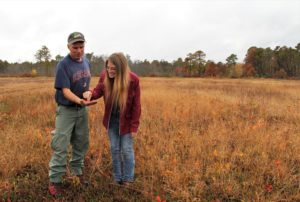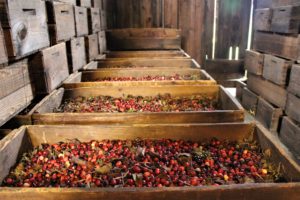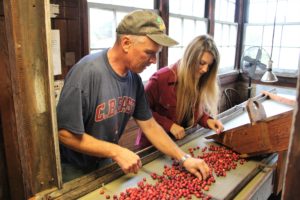
Tom Gerber is the owner of Quoexin Cranberry Company, one of the oldest cranberry operations in the state.
By Teresa Wisniewski, FSA
Tom Gerber is a fourth-generation farmer and owner of Quoexin Cranberry Company in Medford, New Jersey. Tom’s cranberry operation is among the oldest in the state.
One of the last independent cranberry growers in New Jersey, Quoexin Cranberry Company follows a more traditional practice of cultivating cranberries. Tom offers farm tours to educate the public and sells his fresh cranberries at local farmers markets and wineries.
Dry Harvest
Tom grew up farming cranberries and blueberries alongside his father and grandfather.
“I was the last one in my generation that could take it over,” Tom said. “I was some sort of last hope to keep the family business alive and I’m hard headed enough to continue because I didn’t want to let my family down.”

Tom’s operation harvests its cranberries by hand using equipment dating back to the early 1900s.
Unlike some other cranberry operations, Tom is one of the few farmers that “dry” harvest cranberries. This means that the iconic method of flooding the cranberry bog is not used. Instead, Tom’s operation harvests its cranberries by hand using equipment dating back to the early 1900s.
In the warmer months, you can find him checking his cranberry plants and managing saplings, or young trees that have begun to sprout in the middle of his bogs.
The cranberry harvest takes place every September and October. It’s important to harvest when it’s dry, so Tom waits for the morning dew to evaporate every day to get to work. Once harvested, the cranberries are sorted in the packing house using a bounce test. Cranberries are hollow fruit, so only the good berries will pass a bounce test.
Working with USDA
Quoexin Cranberry Company is surrounded by preserved pineland forests. In his spare time, Tom works for the New Jersey Forest Fire Service. He will soon be able to use control burns around the outskirts of his property to help control the encroaching forest and protect his cranberry bogs.
Tom participates in USDA programs from both the Farm Service Agency and the Natural Resources Conservation Service. He gives credit to USDA for stepping in to assist with restoring flood gates when historic storms have washed the infrastructure out with flood waters.
Emergency Conservation Program through FSA financially helped Tom clear fallen trees and other debris that had fallen in bogs and damaged water gates. The program helps farmers and ranchers to repair damage to farmlands caused by natural disasters and to help put in place methods for water conservation during severe drought.
“FSA has always been there for really hard or tight times for funding and through natural disasters,” said Tom. “They’ve really helped keep farming alive.”

Once harvested, the cranberries are sorted in the packing house using a bounce test. Only the good berries will pass a bounce test.
Tom works with NRCS to implement conservation practices through the Environmental Quality Incentives Program, which provides financial and technical assistance to producers to address natural resource concerns and deliver environmental benefits.
“EQIP has been beneficial to me as a small cranberry grower with updating irrigation equipment, irrigation infrastructure, water control and flumes,” said Tom. “It’s been extremely valuable.”
More Information
USDA offers a variety of risk management, disaster assistance, loan, and conservation programs to help agricultural producers in the United States weather ups and downs in the market and recover from natural disasters as well as invest in improvements to their operations. Learn about additional programs.
For more information about USDA programs and services, contact your local USDA service center.
Join the Conversation
Follow the #FridaysOnTheFarm story series and other news you can use on farmers.gov and our social media channels: Twitter, Instagram, YouTube, Flickr, and Facebook.
For an interactive version of this blog, visit #FridaysOnTheFarm.





